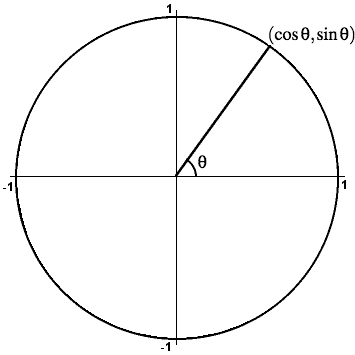Phase Shift Identities
The identities on this page are about angles that differ by a right angle.

Start with the angle θ in standard position. Add a right angle to θ, so angle AOC measures θ + π/2 = θ + 90° and C has coordinates (cos(θ + π/2),sin(θ + π/2)) = (cos(θ + 90°),sin(θ + 90°)). Since angle AOB is a right angle, the angle BOC is &theta.
Rotating the angle AOP by a right angle counterclockwise around the origin shows that the length OE = OD = cos(θ) and the length EC = DP = sin(θ). Thus C also has coordinates (-sin(θ),cos(&theta)). Therefore:
cos(θ+π/2) = - sin θ & sin(θ+π/2) = cos θ
or
cos(θ+90°) = - sin θ & sin(θ+90°) = cos θ.
Two more identities can now be obtained easily. The angle AOF is obtained by subtracting a right angle from &theta, so F has coordinates (cos(&theta - π/2),cos(&theta - π/2)). Notice that &theta - π/2 = &theta - 90° and &theta + π/2 = &theta + 90° differ by a straight angle. This means the points C and F are on opposite sides of the unit circle, and so the coordinates of F have the opposite signs of the coordinates of the point C, that is, F also has coordinates (sin(θ),-cos(&theta)). Therefore:
cos(θ-π/2) = sin θ & sin(θ-π/2) = - cos θ
or
cos(θ-90°) = sin θ & sin(θ-90°) = - cos θ.
Although the diagram shows the angle θ in the first quadrant, the same conclusions can be reached when θ lies in any quadrant, and so these identities hold for all angles θ.
The reason for calling these identities phase shift identities becomes clear when the functions of cos θ and sin &theta are graphed: the identities show that the graph of cos θ is the same as that of sin(&theta + π/2), which is the graph of sin &theta translated π/2 to the left. Such a translation is called a phase shift. Other identities, such as the opposite angle identities, can also be recognized as phase shift identities (with different phase shifts).
Restore initial diagram
